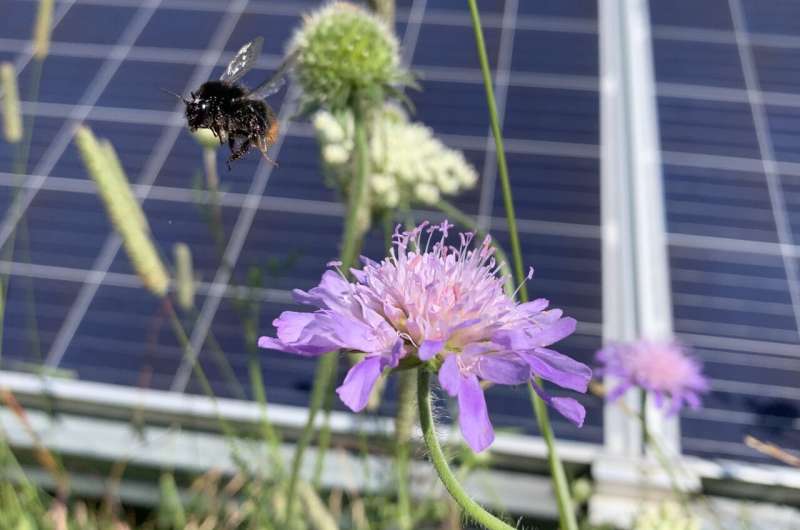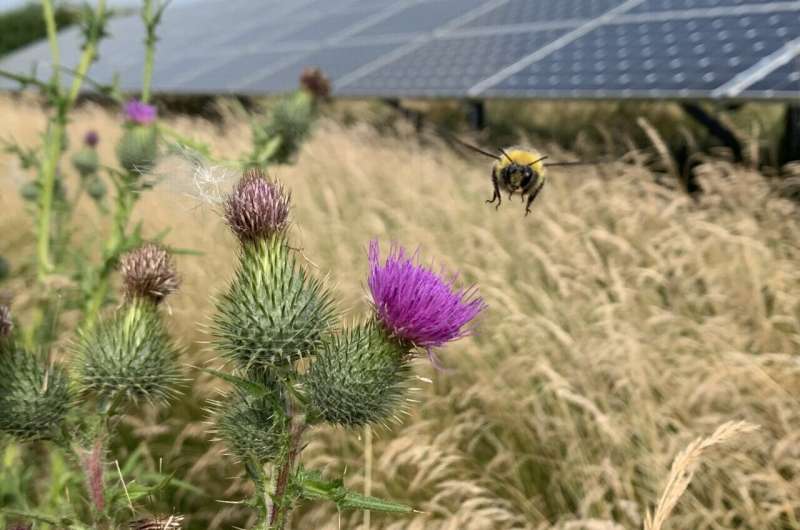11 Dec 2024

Tired Earth
By The Editorial Board

Could solar energy be a win-win solution for both the climate crisis and biodiversity loss?
Research presented at the Ecology Across Borders conference on December 13 shows how solar parks in the United Kingdom could be designed and managed to support the populations of ground-nesting bumblebees.
“Managing the vegetation inside the solar park to provide floral and nesting resources may be the one of the most effective ways that solar parks could help bumblebees,” Lancaster University Ph.D. researcher Hollie Blaydes, who presented the findings at the conference, tells Treehugger in an email. “Specifically, we predict more than four times as many bumblebees forage inside solar parks managed as meadow, compared to those managed as turf grass.”
The research comes in the midst of what scientists are calling an “insect apocalypse” as the abundance of bugs around the world is falling by 1 to 2% each year. This decline is largely because of human activities like deforestation, climate change, agriculture, the introduction of competing species, and pollution.
Bumblebees are among the insects suffering this loss. In the U.K., two bumblebee species went extinct during the 20th century, according to the Bumblebee Conservation Trust. A third of the remaining species—eight in total—are listed on at least one English, Scottish, or Welsh priority list because of their shrinking ranges.
“These declines have occurred mainly because of large-scale changes to the way the countryside is managed,” the trust explains. “First the mechanisation of agriculture, then later the public demand for cheap food, the need for ever-greater quantities of food and crops, and the increasing reluctance to buy ‘wonky’ fruit and vegetables have conspired to hugely reduce the nationwide density of the flowering plants that bumblebees feed on, as well as the sheltered corners that they nest and overwinter in.”
Solar parks present an opportunity to manage land differently in a way that would boost pollinator populations instead of harming them. Previously, Blaydes and her research team looked at 185 articles to assess what solar park management practices in northwest Europe might increase pollinator populations. They found that management actions, resources, and the landscape surrounding a park all played important roles.
“We wanted to explore this further and so in our most recent work we investigated how solar park characteristics (management, size, shape, and landscape context) might impact bumblebee populations inside solar parks and in the surroundings,” Blaydes says.
To do this, the researchers created a variety of solar parks using a geographic information system (GIS) based on real solar parks in the U.K., a Lancaster University press release explained. They then used the pollinator model Poll4Pop to predict the density of bumblebees and their nests within the parks and the surrounding area.
They found that large, long, and resource-full parks could boost bumblebee numbers within one kilometer (approximately 0.6 miles) of the park itself.
Because solar parks are often located near agricultural land, bee-friendly parks could also boost local crops while acting as a refuge for bees.

Blaydes and her team would like their ideal, bee-friendly solar parks to move from model to reality. There are already signs that things are moving in this direction. Solar Energy UK has established a Natural Capital working group and issued a report on the Natural Capital Value of Solar.
“By supporting healthy ecosystems at a local level whilst avoiding climate change-causing emissions from coal and gas power stations, solar PV can play a significant role in the U.K.’s response to both the climate and biodiversity emergencies,” Solar Energy UK Chief Executive Chris Hewitt said in a statement accompanying that report.
Blaydes says some parks have developed pollinator-friendly plans or designed “biodiversity areas” that usually include flowers. However, she would like to see this taken further.
“[W]e hope that our research will highlight one of the potential biodiversity benefits that could be achieved on solar parks and provide evidence to underpin implementation going forward,” she says.
One challenge to making this solution a reality is that it can cost extra money on the part of the solar industry, the press release pointed out. One workaround would be for the government to provide incentives for these companies to make their parks pollinator-friendly, potentially through the post-Brexit agricultural bill.
However, bee-friendly parks also don’t have to be limited to the U.K. Blaydes said her team’s particular research would likely apply to other places with a temperature climate, such as northwest Europe.
Blaydes and her team are also working to move their research into the field. They have been collecting data on how pollinators respond to actual solar parks this summer, and hope to present their findings in 2022.
But the research Blaydes presented last week has already generated a buzz.
“There was a lot of interest from researchers with different backgrounds, from those interested in the pollinator aspect of the study, to others curious about the emerging potential to use developments like solar parks as a conservation tool,” she says.
Source : treehugger.com
Comment